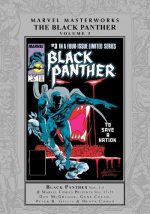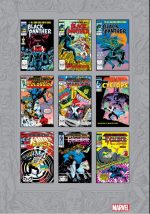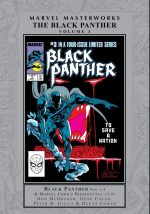


By Peter B. Gillis, Don McGregor, Gene Colan, Denys Cowan, Tom Palmer & various (Marvel)
ISBN: 978-1-3029-2869-8 (HB)
Lauded as the first black superhero in American comics and one of the first to carry his own series, the Black Panther‘s popularity and fortunes have waxed and waned since the 1960s when he first attacked the FF (in Fantastic Four #52; cover-dated July 1966) as part of an elaborate plan to gain vengeance on the murderer of his father. Happy 55thAnniversary, guys!
T’Challa, son of T’Chaka was revealed as an African monarch whose hidden kingdom was the only source of a vibration-absorbing alien metal upon which the country’s immense wealth was founded. Those mineral riches – derived from a fallen meteor which struck the continent in primeval antiquity – had powered his country’s transformation into a technological wonderland. That tribal wealth had long been guarded by a hereditary feline-garbed champion deriving physical advantages from secret ceremonies and a mysterious heart-shaped herb that ensured the generational dominance of the nation’s warrior Panther Cult.
Peter Gillis’ Introduction ‘Travels with T’Challa’ details the long journey to publication for the original deeply-politicised anti-apartheid yarn and is followed by ‘To Follow the track of The Great Cat with renewed wonder on his Panther’s Quest (From “Panther’s Rage†to “Panther’s Preyâ€)’: a typically effulgent and informative Introduction from venerable author McGregor detailing his own lengthy association with “The Great Cat†and the landmark saga re-presented here…
Collected in this sterling hardback and digital collection is a much-delayed miniseries conceived and mostly crafted in 1984 but only completed and released between July to October 1988, as well as the astounding serial from fortnightly anthology Marvel Comics Presents # 13-37 running (February to December 1989).
As the 1980s closed, the Panther made a dynamic comeback after years of absence and occasional cameos, courtesy of writer Peter B. Gillis and illustrators Denys Cowan & Sam DeLarosa…
The Black Panthers rule over a fantastic African paradise which isolated itself from the rest of the world millennia ago. Blessed with unimaginable resources – both natural and not so much – Wakanda developed uninterrupted into the most technologically advanced human nation on Earth, utterly unmolested by rapacious European imperialism. That did not mean, however, geographical neighbours were allies, …
In ‘Cry, the Accursed Country!’ technologically-advanced white nationalist bastion Azania has subjugated and tormented its own black majority population for centuries whilst plotting Wakanda’s downfall. As global condemnation of the apartheid regime mounts, T’Challa learns that the Panther God has withdrawn its blessing: consecrating and empowering as a new Black Panther a priest imprisoned in Azania. When this savage avatar begins inflicting bloody retribution on the ruling class, the Azanians blame Wakanda…
Deprived of his feline blessings and herding war-hungry dissidents in his own nation, T’Challa faces a crisis of confidence – and faith – in ‘For Duty, For Honor, For Country!’ which is no help when Azania targets Wakanda with its own super-agents: The Supremacists…
Soon T’Challa’s people face international condemnation and nuclear Armageddon after ‘The Moorbecx Communique!’adds layers of espionage to the escalating crisis, compelling the outcast king to risk his principles and challenge his god to regain his birthright in ‘A Cat Can Look at a King…’
Most tragically, the Panther must defeat his dark mirror image and knows that, win or lose, nothing will ever be the same again…
That notion was confirmed mere months later when new fortnightly anthology Marvel Comics Presents offered a long-clamoured-for thematic sequel to a legendary epic. Lyrical intellectual Don McGregor immortalised T’Challa in a stunning 1970s periodical run which generated the revered Panther’s Rage saga and controversial Panther vs the Klan storyline. After years away from mainstream comics, crafting groundbreaking graphic novels such as Sabre: Slow Fade of an Endangered Species and Detectives Inc. and series such as Ragamuffins and Nathaniel Dusk, he was lured back to his roots to spin a shocking tale of contemporary intolerance and the end-days of Apartheid…
He was joined by a deeply sympatico, semi-regular collaborator whose credentials in crafting human-scaled tales of adventure, horror and empathetic emotional drama were second to none. He was also one the industry’s earliest exponents of strong black characters…
Eugene Jules “Gene†Colan (September 1st 1926 – June 23rd 2011) was one of comics’ greatest talents: a quietly professional artist who valued accuracy and authenticity in his work, whether science fiction, horror, war, satirical humour or the vast number of superheroes he brought to life.
A devotee of classic adventure strips, Colan studied at the Art Students League of New York, before beginning his own career in 1944 (on Wings Comics) before military service in the Philippines. The war had just ended and Colan had time to draw for local paper The Manilla Times.
By 1946 he was a civilian again, and working under Stan Lee for Atlas on supernatural, crime and other genre stories. He illustrated the last Golden Age Captain America (Captain America’s Weird Tales #75; February 1950), an all-horror issue sans any superhero material at all. It was like a sign…
As the industry radically transformed, he began freelancing at DC/National Comics whilst remaining an Atlas mainstay. His assignments increasingly focused on new genres: War and Romance.
As Superhero stories returned, he moved exclusively to Marvel (except for a range of monochrome horror stories done for Archie Goodwin at Warren Magazines), where his dynamic realism offered a powerful alternative to the graphic stylisations of Jack Kirby, Steve Ditko, John Romita and Don Heck.
Colan became renowned for Daredevil (where he created blind black detective Willie Lincoln), Captain America, Doctor Strange, Iron Man, Avengers, Sub-Mariner and Howard the Duck. During this period, he co-created Guardians of the Galaxy, two Captain Marvels (Mar-Vell and Carol Danvers), drew all of Tomb of Dracula – thereby introducing Blade the Vampire Slayer to the world – and was responsible for another black comic book icon (and the nation’s first African American costumed hero), The Falcon.
In the 1980s he returned to DC, working on Batman, Superman, Wonder Woman, and The Spectre, co-creating Night Force, Silverblade, Jemm, Son of Saturn and period private eye Nathanial Dusk before graduating into independent comics at the forefront of innovation that marked the rise of the Direct Sales Market.
His later career was blighted by health issues, but he continued drawing whenever he could, for many companies. On one of his periodic returns to Marvel he reunited with McGregor for this astounding tale: serialised in in 25 fortnightly chapters in MCP #13-37 (February to December1989).
One of the most thought-provoking mainstream comics tales ever created, Panther’s Quest added pressure to the ever-growing Anti-Apartheid movement in comics and western media, by examining not only the condition of racial inequality but also turning a damning eye on sexual oppression. Whether in his numerous solo series or as part of super-teams such as The Avengers, Fantastic Four or The Ultimates, Black Panther has always been one of Marvel’s most politically strident and socially-crusading characters.
Inked in its entirety by perfect partner Tom Palmer, it begins on a dark night as the Panther infiltrates neighbouring totalitarian South Africa where a white minority oppresses the millions of blacks who live there. T’Challa has heard ‘A Rumour of Life’ and come seeking his stepmother Ramonda. His father’s second wife had raised the bereaved boy when T’Challa’s birth mother died, but one day when he was only three, she vanished and no one would speak of her. Now, he’s invaded the most dangerous land on Earth – for his kind – in search of answers from unscrupulous information peddler Patrick Slade…
‘Forgotten Corpses’ observes that clandestine meeting savagely interrupted by white paramilitaries seeking to kill them – but without alerting police or security services…
McGregor has always a fascination with the real effects and consequences of violence, and this tale contains some pretty shocking moments that will make many readers wince. Suffice it to say I’m staying vague throughout this review, but will say that vicious brute Elmer Gore graphically tortures the Panther with barbed wire in ‘Lost Blood in Copper Dust’, leading to the maimed hero staggering into the arms of ‘The Man Who Loved Sunrise’.
Narrative voice of the ordinary man Zanti Chikane is a black miner and second-class citizen crushed by his intolerable life, but he stifles his understandable caution to offer assistance to torn, bleeding T’Challa. That leads to his own brush with death as white killers employ what they consider ‘Reasonable Force’ against the suspects, before being trounced by the still-fighting cat-man…
The scene changes with ‘Naked Exposures’ as government Magistrate of Communications Anton Pretorius orders his well-pummelled, furious minions to capture invading masked terrorist Black Panther. The invader is a threat to national security but the mercenaries need no other reasons to kill the treacherous “kaffirâ€. Just to be sure, though, Pretorius also uses his position to send out a nationwide TV alert…
‘Battered Artifacts’ finds T’Challa tracking Slade to an impoverished township, unaware that he’s under surveillance and about to step into the other side of the deadly politics that wracked South Africa at this time. ‘Hatred under Tears’ sees the mercenaries attack, uncaring of the small children they are endangering. As the Great Cat stops to aid a tear-gassed toddler, ‘Justifiable Action’ sees him shot for his efforts and arrested in ‘Personal Risk’ before breaking free and escaping…
‘The Official Version’ gives T’Challa a lesson in realpolitik from Slade’s wife, even as the State intensifies its hunt for him, with Security Minister Doeke Riebeek officially branding the entire emergency a communist plot…
In the township ‘Voices Heard, Voices Ignored’ finds Zanti pondering the terrifying dangers to his family before returning to aid the Panther, whilst ‘A Right to Kill’ shows Riebeek beginning to suspect Pretorius’ motives. Meanwhile, the enraged township men move against a suspected traitor determined ‘Somebody’s Going to Pay’. They’re carrying petrol and tyres needed for the appalling punishment they call “necklacingâ€. Do not google it or buy this book if you have a weak stomach…
When the Panther acts to save a life, he is horribly burned but events escalate to total tragedy as ‘Last Night I Wept for Freedom’ shows how the boy he helped returns the favour and pays the ultimate price, despite his own superhuman efforts and the initially-reluctant intervention of a white doctor in ‘Lost Promises’…
Traumatised and repentant, T’Challa returns to Slade whose ‘Dark Maneuvers’ lead them into a trap laid by Pretorius’ mercenaries in ‘So Many Nameless Enemies’. The battle is brief but provides a crucial clue in the true quest, as the trader reveals how, years ago, he learned of a black woman held in glittering bondage for decades in the home of a high-ranking government official…
‘Chances’ see Riebeek’s forces closing in as T’Challa follows his fresh clue to Johannesburg, confronting one merc in ‘The Great Cat in the City of Gold’. Now focused on Pretorius, the Panther and Zanti attempt to save his precious stealth-ship from being taken by Riebeek in ‘Losing Control’… but at a terrible cost…
After ‘Saying Goodbye’, the quest moves into its endgame as T’Challa assaults Pretorius’ luxurious citadel, circumventing deadly ‘Barriers’; crushing human and canine ‘Opponents’ (still more grimly authentic action in need of a strong stomach advisory…) to ultimately rescue Ramonda from the luxurious cell she has inhabited ever since Pretorius abducted her decades ago.
The tyrannical hypocrite’s obsessive, abusive passion for her was also his downfall: a secret capable of destroying him in a nation and government that decreed interracial mixing immoral, unnatural and illegal. Ultimately, it’s Ramonda who decrees his fate whilst enjoying a ‘Dawn Reunion’ with her long-lost child…
The edgily barbed political fantasy is augmented by a full cover gallery, pages and maps of Wakanda fromThe Official Handbook of the Marvel Universe, featuring T’Challa, Central Wakanda, Klaw, Klaw’s Blaster and Kiber the Cruel. There are also text features from Marvel Age #20 and #63 covering the Gillis/Cowan revival, plus pinups from Steve Rude (Marvel Fanfare #45) and Bill Reinhold (Marvel Fanfare #41), and the cover of Panther’s Quest 2017 collection it was eventually adapted for …
An explosive rocket ride of thrills, spills, chills, delayed gratification, and potent commentary, these long-lost classics confirm the Black Panther as one of the most complex and versatile characters in comics and simply scream “Read me! Read me!†You should, and you must…
© 2021 MARVEL
